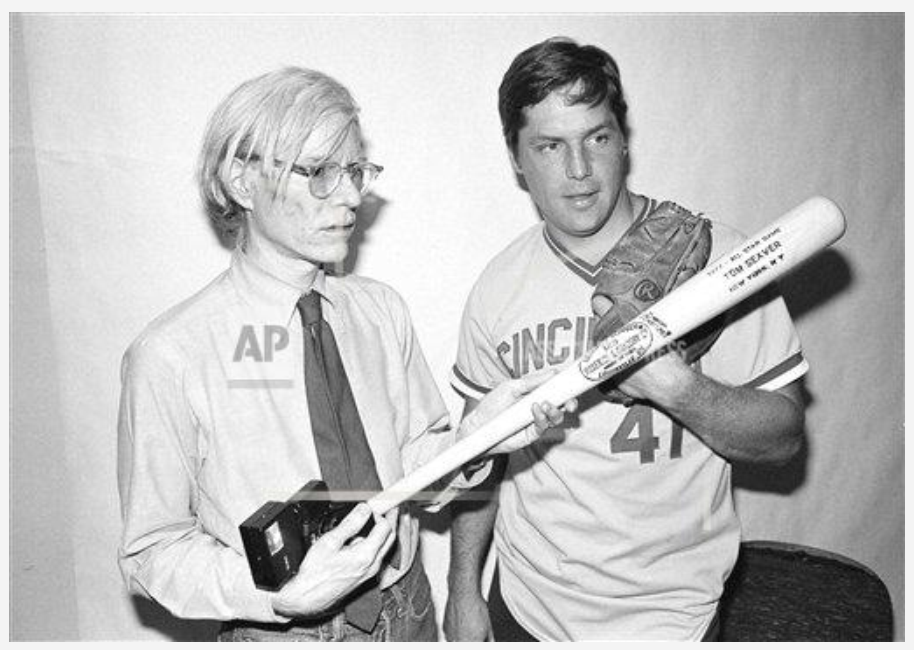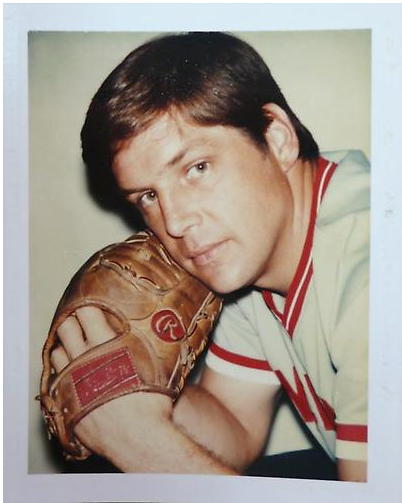The commission of Andy Warhol's Athletes Series was funded by investment banker and art collector Richard Weisman. Since Warhol was unfamiliar with figures in the sports world if fell on Richard Weisman to pick the subjects. The first two athletes he picked were New York Rangers Hockey player Rod Gilbert and Tom Seaver.
Part of the reason the two were chosen was proximity, both athletes played for New York teams which simplified getting them to Andy Warhol's studio which was also located in the city.
Unfortunately for Weisman on June 15th 1977 the New York Mets traded Tom Seaver to the New York Mets.
Seaver's first return to New York was just under a month later for the All-Star Game at Yankee stadium on July 19th. A day later Tom Seaver was at Andy Warhol's factory to sit for his Athletes Portrait.
 AP Images / Rene Perez
AP Images / Rene Perez
I love this photo. Two of New York's most iconic figures from the mid-1970s. They have the tools of their trade in hand, Andy with his camera, Tom with his glove. In the quaint pre-MegaMerchandising days of 1977 the players likely didn't wear special uniforms for special games so I am thinking there is a good chance that the Travel Jersey worn by Seaver here may be the same one he wore during the previous nights All-Star game.
Thanks to Rene Perez, who is now a fine art photographer, we have several great photos of the Seaver portrait sitting. The pictures are a nice document of how Andy Warhol worked while with a portrait subject.
I am think the above photo is of our two heroes executing a celebrity gift exchange. Seaver is likely giving Warhol and autographed bat, in return Tom probably received a signed copy of Andy's most recent book at the time which was "The Philosophy of Andy Warhol"
As a side note, I learned from the Louisville Slugger tour that they brand the player signature onto the bat if there is an exclusive deal between the parties. Otherwise, players getting bats from multiple companies receive the block letter treatment that is on the Seaver bat.
 AP Images / Rene Perez
AP Images / Rene Perez
For the reference photos Andy Warhol used a Polaroid Big Shot camera, which we see in this second Rene Perez photo. To read more about the camera check out
Camerapedia.
Warhol found the camera favorable for a couple of reasons, first and foremost he liked the pictures it took, secondly I believe the artist liked the intimacy it created between him and his subject. To take a good picture Polaroid cameras require the photographer to be in close proximity of the subject. This closeness is important to an artist who may only spend an hour with his subject.
Finally Polaroids provided one other asset in the pre-digital 1970s...
 AP Images / Rene Perez
AP Images / Rene Perez
Instant feedback.
This way Andy Warhol could find out which pictures Seaver liked and which he did not. Typically a few of these Polaroids would be blown up to a large size and Andy would choose one to create the stencil for the final silkscreen.
The Polaroid ultimately chosen is below:

To see the Warhol-Seaver Polaroids we have found click
here.
Carlos Rene Perez
The black and white photos in this post were taken by Rene Perez who was working as a stringer at the time. He is still active and has some fine art photography I found interesting especially his Edward Hopper inspired pictures, his website can be found
here.
The Warhol Portrait Process
For as ubiquitous as Andy Warhol was with celebrities during the 1970s pictures documenting him at work seem pretty rare on line. We are very lucky to have the Rene Perez which happen to feature a Hall of Fame pitcher. The only other pictures I found in Getty Images were of Warhol's session with pop artist
Pia Zadora.
There is also a 20/20 segment on YouTube that features Andy photographing model
Farah Fawcett.
Sources and Links
Andy Warhol Tom Seaver Index
Andy Warhol Index
The Warhol Diaries
Rene Perez
AP Images
Danziger Gallery
Getty Images / Life Magazine
youtube (20/20)














